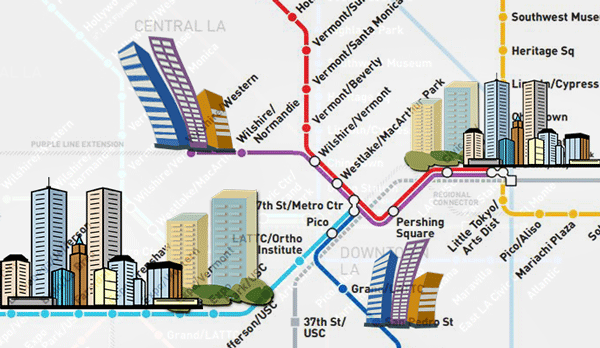From TRD LA: A new city planning initiative aims to add affordable housing development near mass transit, but some real estate insiders question whether it does enough to entice market-rate builders.
The Los Angeles Department of City Planning released the official Transit Oriented Communities (TOC) Affordable Housing Incentive Program Guidelines on Sept. 22. The new rules aim to streamline the development process and incentivize affordable housing development by implementing a section of Measure JJJ, which was passed by voters in Nov. 2016.
Roughly 20 applications have been submitted since the guidelines were released. Experts predict the TOC program will be most effective at increasing the scale of affordable projects. Whether it does enough to bring market-rate developers into the affordable housing business — which experts say is essential to tackle the housing crisis — is less certain.
“I see it benefiting mostly developers that already focus on affordable housing as their core product,” said Doug Bystry, CEO of Clearinghouse CDFI and a former La Habra City Council member.
Cost cutting
Allan Abshez, a land use and zoning attorney at Loeb & Loeb, said he is unsure whether developers will use the TOC guidelines more than they use the state’s existing density bonus program.
The city program will be available to projects located near transit hubs that fit JJJ’s requirements, including mandates to pay construction workers union-level wages and set aside a portion of units as affordable housing. It’s unclear whether the density bonuses it allows for will sufficiently offset the higher costs those requirements incur. Existing bonuses have not done so in the past, Abshez said.
“The standard density bonuses…did not produce a large market reaction to pursue affordable housing,” Abshez said. “To date, multifamily builders have incorporated density bonus housing as a political accommodation to get projects approved.”
Others are more optimistic. Jim Ries of Craig Lawson & Co., a land-use consulting firm, expects market-rate developers to jump on board because of the cost savings a shorter entitlement process bringst.
“You’re increasing the unit count, which helps with the financial feasibility of building affordable housing,” he said. “And you’re removing one of the biggest obstacles, which is going through the entitlements process.”
Simon Ha of Steinberg Architects said TOC’s reduction of parking requirements could tip the scale in developers’ favor.
“The parking requirements are very low which equates to lower cost of production,” said Ha. “The affordable housing provided through TOC will exempt the project from the Affordable Housing Linkage Fee (an expected-to-pass construction fee on developers that will go toward affordable housing). More market-rate housing, more affordable housing, less parking around transit, it’s a win-win-win and it’s all by-right.”
The nitty gritty
Most incentive-eligible areas are clustered around transit stops in Downtown Los Angeles, but they also pop in South L.A. and Mid-Wilsire along the train lines and follow major north-south transit lines in the San Fernando Valley, from Hollywood and Westwood south to Mid-City. There is also a small grouping around the Port of San Pedro.
The guidelines apply to all housing developments within a half-mile radius of an existing or planned rail station or the intersection of two or more bus routes with service intervals of 15 minutes or less at peak hours. The closer the development to a transit stop, the greater the incentives.
Housing developments fall into four tiers of eligibility, with increasing percentages of on-site affordable units out of the final number of available units.
When using these incentives, developers can’t seek any other density or development bonuses through General Plan Amendments or zoning changes. Base incentives, which are available to all eligible housing developments, apply to density and parking requirements. Developments can be eligible for up to three additional incentives with increased levels of affordability.
Developers can build projects with between 50 and 80 percent more units than the zoning code allows, depending on the tier, unless a development lies in a Restricted Density Multi-Family Zone (RD), in which case they can still build 35 to 45 percent more units. Developers can also increase the Floor Area Ratio (FAR) allowed in the code by between 40 and 55 percent, or 2.75:1 and 4.25:1 in commercial zones – whichever is greater. The higher the FAR, the denser the development on the property.
Parking restrictions are eased up in tiers 1-3, which applies to projects within 2,640 feet of a major transit stop. They call for no more than 0.5 spaces per unit. If the development is 100 percent affordable, parking is not required at all. Nor is it required at tier 4 developments, which are within 750 feet of an intersection of two Metro Rail lines or Rapid Bus lines.
What’s the impact?
Craig Lawson’s Ries expects the program to push both affordable and market-rate developers.
“It reduces a lot of the uncertainty,” he said. “I’m hopeful that it will spur a lot of development around these transit hubs.”
Bystry of Clearinghouse was more circumspect, pointing to the strong economy and robust demand for market-rate units.
“I don’t believe that this [program] will really move the needle,” he said.
If the economy falters and housing starts fall, however, it could become a bigger factor.
“We’ve seen market rate-developers get very interested in affordable housing development when times are lean,” he said.
